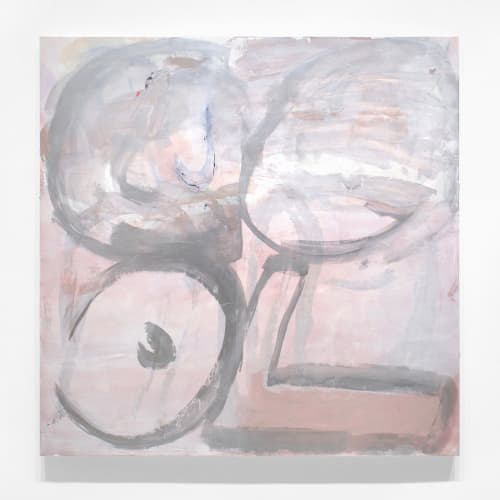Inman Gallery is pleased to present a solo exhibition of new paintings by Dana Frankfort, entitled there was a stone. Opening with an artist's reception on Friday, January 19, from 6-8pm, the exhibition will continue through Saturday, February 24, 2018.
For over two decades, Dana Frankfort has explored the vexing periphery between language and sight by painting words. Rather than laying claim to the paintings, controlling their semiotic pulse, her words serve as the formal armature; they prop up, ventilate, and allow the many layers of paint to breathe. Imperatives, allusions, evocations-the words dissolve into a palimpsest of obscured serifs and stems, into color and form.
The works in there was a stone, Frankfort's first exhibition of new paintings in seven years, are her least legible. As such, they mark a refinement, and a departure. They function as signs and reminders. They point backward, to their inception, and forward, to their being seen by the viewer. Thin layers of oil paint combine to create a dense scrim, a case file of the work's anxious history.
As she paints, Frankfort sands down, creating a fraught tension between the done and the undone. This history is often only visible when viewed aslant; only then do you see the whispered conversation of colors on the surface of the work, the palindrome of layers on the side. It is the thrill of adjacency that charges these works-that excitement of meaning about to enter the room, or having just left.
Magical Marker is boisterous, its billowing forms slashed through with white, as if the carnival has been cancelled, the posters torn down. Above these obfuscating white clouds we see the purple, cursive peaks of the letters. So much painting of words (Lawrence Weiner, Christopher Wool, etc.) falls tangled in the semiotic briar. Here, it's refreshing to see these words as nothing more than remnants of wrist flicks, condensation from the act of writing, of speaking.
Edna Mayer provides a similar trace. The name, which belongs to the painter of a thrift-store painting Frankfort has kept on her wall for twenty years, is near impossible to read. The interstitial has won out; we map the space within and around the letters-a Turneresque cloudburst of scrubbed purples and oranges. The painting recalls a tombstone rubbing.
Some of these paintings, as well as the name of the exhibition, spring from Carlos Drummond de Andrade's "In the Middle of Road." Here it is, translated from the Portuguese by Elizabeth Bishop:
In the middle of the road there was a stone
there was a stone in the middle of the road
there was a stone
in the middle of the road there was a stone.
Never should I forget this event
in the life of my fatigued retinas.
Never should I forget that in the middle of the road
there was a stone
there was a stone in the middle of the road
in the middle of the road there was a stone.
Throughout, Frankfort's paintings tilt on the edge of being; they are both tentative and fixed. And though long in the making, the product of layering and anxious erasure, each appears anew with every viewing. In her work, she achieves an arbitrary predestination. The words themselves are both definitive and happenstance, mainly offering a conceptual substrate Frankfort can then bury with fields of color. The language does not define the palette, nor the other way around, but of course there is going to be some bleed-through. That's just how language works. A word itself is unimportant. What matters is that it allowed Frankfort to begin the painting, to complete it.

